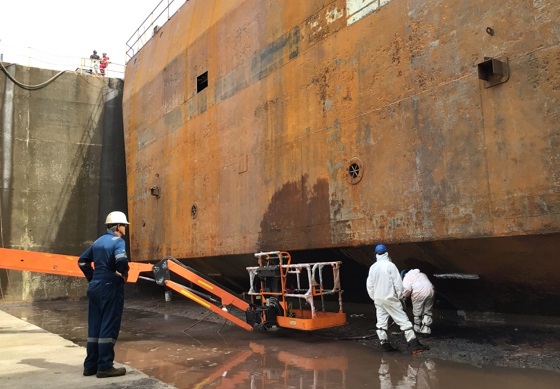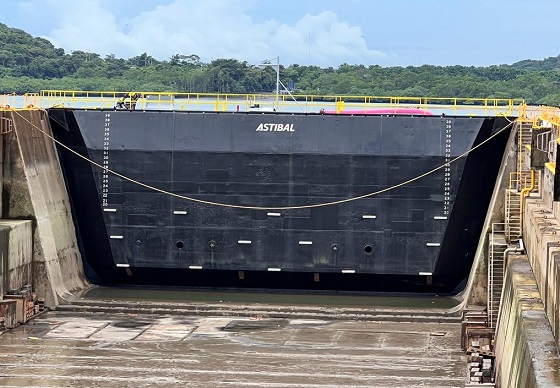The Balboa Shipyard, the largest Pacific shipyard facility from Chile to California, is capable of handling Panamax-sized vessels in one of its dry docks. It’s located in a very strategic geographical area where vessels can undergo maintenance and repair and then continue their commercial routes through the Panama Canal.
The shipyard opened in 1914 along with the Panama Canal and was operated by the United States until 1979, when both the shipyard and the canal were handed over to Panama. Since then, the Balboa Shipyard has been managed by various administrations. Unfortunately, the shipyard was closed in 2018, but it did partially reopen in the summer of 2020.
Recently, the Panama Maritime Authority (PMA, also referred to as AMP locally) placed a bid to operate the Balboa Shipyard over the next 20 years, allowing the shipyard’s vessel repair business to fully reopen. This move will create regional and global business opportunities in Panama for companies seeking to provide specialized services, equipment, and products for ship repair.
To achieve long-term success, PMA needed an operator with world-class shipyard expertise and advanced cultural knowledge as well as a thorough knowledge of industry standards and best practices. Reaching these goals and contributing to the development of the regional and global marine industry would also require experienced and qualified personnel, along with a collective industry vision from all parties involved.
Astilleros Canarios (ASTICAN), a privately owned ship repair yard from Spain, was selected in the bid process to rehabilitate, develop, and provide administration for the Panamanian shipyard. ASTICAN has highly experienced staff, and its main business operations include the repair, maintenance, and conversion of all types of vessels, structures, marine renewable energy devices, and offshore units. (“Astican Shipyard: Ship Repair, maintenance, conversion. Offshore units ...”)
Technical operations at the Balboa Shipyard — also called the Astillero Puerto de Balboa (ASTIBAL) — are managed by Technical Director Alberto Porras, who directed an exhaustive inspection and condition assessment of the infrastructure. Porras also leads a professional group of experienced naval engineers from other ASTICAN shipyards to oversee all management details in the rehabilitation process.

ASTIBAL is currently recruiting local naval industry professionals to support the complex operations of the shipyard. ASTIBAL’s long-term dedication to the region extends to helping develop the future naval workforce by providing financial support to Panamanian universities.
During the shipyard’s rehabilitation, concrete and steel structures, pump systems, miter gates, caissons, and electrical and mechanical systems will all require repairs. ASTIBAL has recruited Panama’s top contractors to ensure that the wide variety of necessary repairs are done right. For surface preparation and coatings applications, ASTIBAL is working with Marine Metal Coatings, an experienced and highly qualified local contractor directed by Harmodio Yuen and Mario Dovo. Yuen and Dovo have more than 40 years of combined experience in these activities.
All surface prep activities during the shipyard’s rehabilitation process have been carried out through waterjetting, one of Marine Metal Coatings’ specialties. Waterjetting is an eco-friendly technology that produces less residue than the alternatives. This cleaner surface prep option not only protects the environment but also promotes worker health and safety. Marine Metal Coatings is currently in charge of the repair work on the smaller dry dock caissons and the miter gate of the Panamax-sized dry dock.
For decades, the Balboa Shipyard has been an important source of employment and business opportunities for local and international craftspeople, inspectors, professionals, contractors, product and equipment manufacturers, and equipment service providers. Under ASTIBAL, the shipyard once more provides a major opportunity to bolster the regional maritime economy.

Because of the investments ASTIBAL is making in the shipyard’s infrastructure, I foresee more international involvement in the region, both in generating new business and employment opportunities and in companies introducing new technologies. I believe these changes will help further develop workers’ knowledge of industry best practices as well as strengthen the ship repair industry in the region and across the globe.
With a shared vision and support from private companies, government entities, industry organizations, private associations, universities, contractors, and craftspeople and other professionals, I see a bright future ahead for the region.
This article was originally published in the March 2023 print issue of CoatingsPro Magazine. Republished with permission.